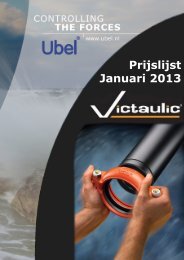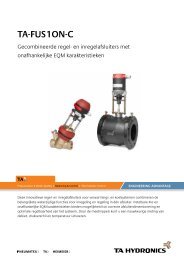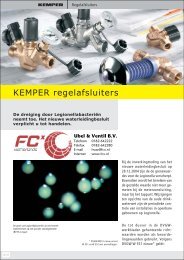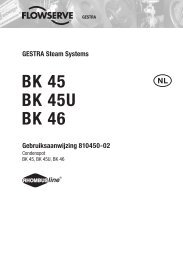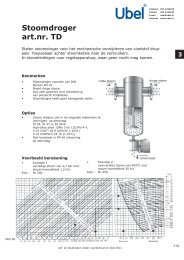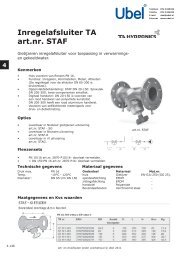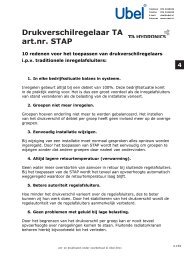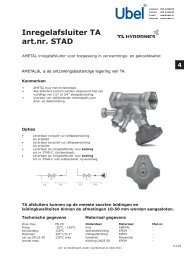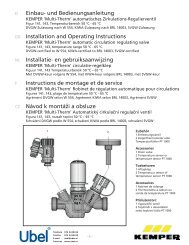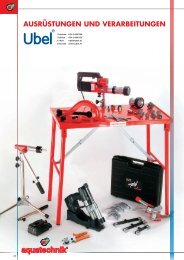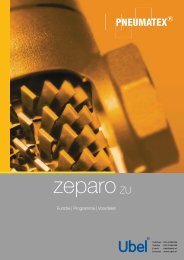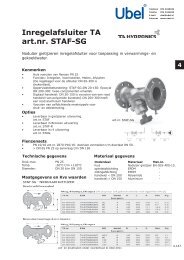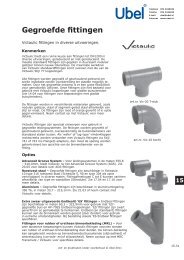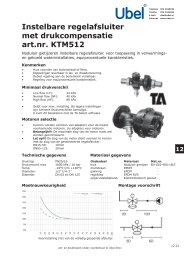Einbau- und Bedienungsanleitung Installation instruction ...
Einbau- und Bedienungsanleitung Installation instruction ...
Einbau- und Bedienungsanleitung Installation instruction ...
Create successful ePaper yourself
Turn your PDF publications into a flip-book with our unique Google optimized e-Paper software.
<strong>Einbau</strong>- <strong>und</strong> <strong>Bedienungsanleitung</strong><br />
<strong>Installation</strong> <strong>instruction</strong><br />
Instructions de montage et de maintenance<br />
KEMPER ´Protect´ Systemtrenner BA Figur 360<br />
KEMPER ´Protect´ backflow preventer BA Figure 360<br />
KEMPER ´Protect´ disconnecteur BA Figure 360<br />
1. <strong>Einbau</strong> - <strong>Installation</strong> - <strong>Installation</strong><br />
<strong>Einbau</strong>beispiel - <strong>Installation</strong> example - Exemple d´installation<br />
DIN EN 1717, DIN EN 12056, DIN 1986-100 beachten<br />
Consider DIN EN 1717, DIN EN 12056, DIN 1986-100<br />
Considérer DIN EN 1717, DIN EN 12056, DIN 1986-100<br />
Nur im frostfreien Raum einbauen!<br />
Install in frost-free area only!<br />
Installer uniquement dans un local<br />
hors gel!<br />
integriert<br />
integrated<br />
intégré<br />
Ablaufleitung vorsehen, <strong>Einbau</strong>lage waagerecht<br />
mit Ablassventil nach unten<br />
Install discharge pipework , mounting position<br />
horizontal with drain valve downward<br />
Prévoir écoulement, position de montage à<br />
l´uorizontale avec vanne de purge vers le bas<br />
Durchflussrichtung beachten!<br />
Consider direction of flow!<br />
Respecter sens de flux!<br />
2. Montage - Assembly - Montage<br />
(1) (2)<br />
(3)<br />
Telefoon 074 2435334<br />
Telefax 074 2434323<br />
E mail ubel@ubel.nl<br />
Internet www.ubel.nl<br />
- 1 -
Die Entlastungsöffnung der Mitteldruckkammer lässt in der Regel (normaler Funktionsfall Druckschwankungen) nur einige<br />
Tropfen Wasser durch. Im Störfall (Versagen der Sicherungskartusche BA) kann die Entlastungsöffnung den vollen<br />
Volumenstrom der Anschlussleitung durchlassen. Hierzu ist der Abwasseranschluss nach DIN EN 12056 <strong>und</strong> DIN 1986-100<br />
ausreichend groß zu dimensionieren. Es ist der Volumenstrom anzunehmen, der durch die Anschlussleitung am<br />
Systemtrenner entstehen kann.<br />
In general, the vent hole in the medium pressure chamber (normal functional case pressure fluctuation) only allows a few<br />
drops of water through. During malfunctions (failure of the protective cartridge BA), the vent hole could allow the entire<br />
volume flow from the connection line through. For that reason, dimension the wastewater connection according to DIN EN<br />
12056 and DIN 1986-100 to be sufficiently large. Assume the volume flow that could arise through the line connection on<br />
the backflow preventer.<br />
En règle générale, l’ouverture de décharge de la chambre de pression moyenne laisse passer seulement quelques gouttes<br />
d’eau (fonctionnement normal, variations de pression). En cas de dysfonctionnement (panne de la cartouche de sécurité BA),<br />
l’ouverture de décharge peut laisser passer le courant complet de la conduite de raccordement. Pour ce faire, il faut que le<br />
raccord des eaux usées soit suffisamment dimensionné, selon DIN EN 12056 et DIN 1986-100. Il faut supposer le débit<br />
volumétrique qui peut se présenter sur le disconnecteur passant par la conduite de raccord.<br />
3. Inbetriebnahme - Commissioning - Mise en service<br />
(1) Absperrventile öffnen<br />
Open shutoff valves<br />
Ouvrir les vannes d´arrêt<br />
1 2<br />
(2) Kurz über Kugelhähne entlüften<br />
Briefly vent the appliance through the ball valves<br />
Purger brièvement par les vannes à bille<br />
1 2 3<br />
(3) Gerät ist betriebsbereit<br />
The appliance is ready for use<br />
Le disconnecteur est en service<br />
- 2 -
4. Inspektion <strong>und</strong> Wartung - Inspection and Maintenance - Inspection et maintenance<br />
In Übereinstimmung mit Standards zum Trinkwasserschutz <strong>und</strong> Hygienevorschriften erhält der Benutzer/Betreiber<br />
folgende Vorgaben:<br />
Nach EN 1717, Punkt 4.6 „Schäden durch mangelnde oder unsachgemäße Wartung“ ist „eine regelmäßige Wartung<br />
der Sicherungseinrichtungen durchzuführen. Ihre ordnungsgemäße Funktion ist regelmäßig in Übereinstimmung mit<br />
nationalen oder regionalen Bestimmungen zu überprüfen.“<br />
Für D ist nach DVGW W 570-1 (April 2007) unter 4.7 festgelegt, dass die Wartung 1x jährlich zu erfolgen hat.<br />
Für die CH ist nach SVGW W3 Ergänzung 1 (2000), W/TPW 126 (April 1994) sowie W/TPW 135 (April 1994) die Wartung/<br />
Inspektion durchzuführen. In W/TPW 135 wird unter Punkt 3 Wartung, periodisch, spätestens aber nach 2 Jahren die<br />
Wartung/Inspektion festgelegt. In W/TPW 126 wird die erste Kontrolle des Systemtrenners nach dem ersten Betriebsjahr<br />
gefordert. Zusätzlich wird auf den Sonderdruck Nr. 1377 des SVGW 8/96 verwiesen.<br />
Für NL ist in dem VEWIN Waterwerkblad WB 1.4 G (November 2005 unter Punkt 4 festgelegt, dass Systemtrenner BA<br />
1x jährlich auf den ordnungsgemäßen Betrieb zu überprüfen <strong>und</strong> zu warten sind.<br />
Es gilt:<br />
Die Funktions- <strong>und</strong> Wartungsmaßnahmen umfassen die Funktionsprüfung, die Sichtkontrolle der Innenteile sowie<br />
die Reinigung bzw. den Austausch der Funktionsteile wie unter Punkt 4 der <strong>Bedienungsanleitung</strong> beschrieben.<br />
Diese Inspektion sollte auch die dazugehörigen Armaturen mit einschließen. Nur autorisiertes Fachpersonal darf die<br />
Überprüfung vornehmen. Die Überprüfung sollte auf dem angehängten Kontrollschild mit<br />
Datum <strong>und</strong> Unterschrift dokumentiert werden. Örtliche Vorschriften sind zu beachten.<br />
In compliance with the standard on drinking water protection and hygiene regulations, the user/operator is given the<br />
following specifications:<br />
Perform regularly scheduled maintenance on the safeguards according to EN 1717, Point 4.6 „Damages caused by<br />
insufficient or improper maintenance“.<br />
Regularly check their proper functioning in compliance with national and regional regulations.“<br />
For DE, according to DVGW W 570-1 (April 2007) in 4.7 it is stipulated that maintenance is to be performed 1 x annually.<br />
For CH, perform the maintenance/inspection according to SVGW W3 Supplement 1 (2000), W/TPW 126 (April 1994) and<br />
W/TPW 135 (April 1994). In W/TPW 135 in Point 3, Maintenance, the maintenance/inspection is stipulated as periodic but<br />
latest after 2 years. In W/TPW 126 the first inspection of the backflow preventer is required<br />
after the first operating year. In addition, we refer to Offprint No. 1377 from SVGW 8/96.<br />
For NL, the VEWIN Waterwerkblad WB 1.4 G (November 2005 Point 4, stipulates that backflow preventer BA is to be<br />
checked and maintained for proper operation.<br />
Applicable is:<br />
The functions and maintenance work comprise the functional check, a visual check of the interior parts and cleaning or<br />
replacement of the functional parts<br />
as described in Point 4 in the operating <strong>instruction</strong>s.<br />
These inspections should also include the related fittings such as strainers and cut-off valves. Only authorised specialists are<br />
allowed to make the inspections.<br />
Document the inspection on the attached inspection plate including the date and a signature. Comply with local<br />
regulations.<br />
- 3 -
En accord avec les standards concernant la protection de l’eau potable et les règlements de l’hygiène, les spécifications<br />
suivantes sont remises à l’utilisateur/l’exploitant:<br />
Selon EN 1717, point 4.6 ‘’Dommages dus à une maintenance défaillante ou incorrecte’’, il faut alors effectuer les travaux<br />
de maintenance régulière des dispositifs de sécurité. Leur bon fonctionnement sera vérifié régulièrement en accord avec les<br />
dispositions nationales ou régionales.<br />
En Allemagne, il a été fixé selon DVGW W 570-1- (avril 2007) au point 4.7 que la maintenance devra être effectuée 1 x par<br />
an.<br />
En Suisse, la maintenance et l’inspection doivent être effectuées selon SVGW W 3, complément 1 (2000), W/TPW 126 (avril<br />
1994) et W/TPW 135 (avril 1994). Selon W/TPW 135, point 3, la maintenance/l’inspection est fixée périodiquement, mais au<br />
plus tard au bout de 2 ans. Selon W/TP W 126, le premier contrôle du disconnecteur est demandé après la première année<br />
de service. En plus, on renvoie à l’imprimé spécial n° 1377 du SVGW 8/96.<br />
Aux Pays-Bas, selon VEWIN Waterwerkblad WB 1.4 G (novembre 2005 au point 4 il est fixé que le disconnecteur BA doit être<br />
vérifié 1 x par an au niveau d’un service régulier et qu’il faut entretenir.<br />
En vigueur :<br />
Les mesures de fonctionnement et de maintenance englobent la vérification du fonctionnement, le contrôle visuel des<br />
pièces intérieures ainsi que le nettoyage, voire le remplacement des pièces de fonction, comme décrit au point 4 des<br />
Instructions de service.<br />
Cette inspection devrait inclure aussi la robinetterie afférente, telle que collecteurs d’impuretés et robinets d’arrêt. Seul du<br />
personnel spécialisé et autorisé doit être chargé de la vérification. La vérification devrait être documentée avec la date et la<br />
signature sur la plaque de contrôle suspendue. Prière de suivre les règlements locaux.<br />
Nur Fachpersonal! - Authorized personnel only! - Uniquement par personnel qualifié!<br />
Messgerät zur Differenzdruckmessung: Geeignete Differenzdruckmanometer;<br />
empfohlen wird KEMPER Differenzdruckmesskoffer Figur 360 99<br />
Differential pressure measuring equipment: suitable differential pressure gauges;<br />
Measuring device KEMPER Figure 360 99 is recommended<br />
Appareil de mesure recommandé: Valise de mesure KEMPER Figure 360 99<br />
4.1 Überprüfen Eingangs-Rückflussverhinderer - Testing the inlet anti-pollution check-valve –<br />
Contrôle du clapet de retenue d´entrée<br />
(1) Messgerät anschließen<br />
Connect a differential pressure kit<br />
Connecter le manomètre de différence de pression<br />
Messgerät nach Punkt 4<br />
Measuring device according to Point 4<br />
Manomètre selon point 4<br />
<strong>Bedienungsanleitung</strong> Figur 360 99 beachten!<br />
Consider user manual of Figure 360 99!<br />
Voir mode d´emploi valise Figure 360 99!<br />
(2) Öffnen der Kugelventile 1 <strong>und</strong> 2<br />
Open ball valves 1 and 2<br />
Ouvrir les vannes à bille 1 et 2<br />
1 2<br />
- 4 -
(3) Absperrventile schließen<br />
Close shutoff valves<br />
Fermer les vannes d´arrêt<br />
(4) Druck in der Zone 2 (Mitteldruckzone) über Entlastungsventil am Differenzdruckmessgerät etwas<br />
abbauen.<br />
- Der Differenzdruck steigt hierbei so lange an, bis der Eingangs-Rückflussverhinderer zu<br />
öffnen beginnt.<br />
- Das Ablassventil darf hierbei nicht entwässern, sonst ist es <strong>und</strong>icht. Mögliche Ursachen sind<br />
Verschmutzung oder mechanischer Defekt.<br />
Relieve the pressure in zone 2 (medium pressure zone) with relief valve on differential pressure gauge.<br />
- The differential pressure then rises until the inlet anti-pollution check-valve starts to open.<br />
- The discharge valve must not discharge water when this is happening, otherwise it is leaking.<br />
Possible causes for this are dirt on the seat or mechanical defect.<br />
Dimineur légèrement la pression dans la partie 2 (pression du milieu) au moyen de la vanne du manomètre de<br />
différence de pression.<br />
- La différence de pression grimpe ainsi jusqu´à ce que le clapet de retenue d´entrée commence à s´ouvrir<br />
- Le clapet d´écoulement ne doit pas couler; s´il coule, il est défectueux. Les causes peuvent être un<br />
encrassement ou une défectuosité mécanique.<br />
(5) Entlastungsventil am Differenzdruckmessgerät wieder schließen.<br />
- Der Differenzdruck muss nun konstant bleiben, sonst ist der Eingangs-Rückflussverhinderer <strong>und</strong>icht.<br />
Mögliche Ursachen sind Verschmutzung oder mechanischer Defekt.<br />
Reclose the relief valve on differential pressure gauge.<br />
- The differential pressure must now remain constant, otherwise the inlet anti-pollution check-valve is leaking.<br />
Possible causes for this are dirt on the seat or mechanical defect.<br />
Refermer la vanne du manomètre.<br />
- La différence de pression doit rester constante, si non, le clapet de retenue d´entrée est défectueux.<br />
Les causes peuvent être un encrassement ou une défectuosité mécanique<br />
(6) Kugelventile 1 <strong>und</strong> 2 schließen<br />
Close ball valves 1 and 2<br />
Fermer les vannes à bille 1 et 2<br />
1 2<br />
1 2<br />
(7) Messgerät entfernen<br />
Remove differential pressure kit<br />
Débrancher le manomètre<br />
(8) Absperrventile öffnen<br />
Open shutoff valves<br />
Ouvrir les vannes d´arrêt<br />
(9) Kurz über Kugelhähne entlüften<br />
Briefly vent the appliance through the ball valves<br />
Purger par les vannes à bille<br />
- 5 -
4.2 Überprüfen Ablassventil - Testing discharge valve – Contrôle du clapet d´écoulement<br />
(1) Messgerät anschließen<br />
Connect differential pressure kit<br />
Connecter le manomètre de différence de pression<br />
Messgerät nach Punkt 4<br />
Measuring device according to point 4<br />
Manomètre selon point 4<br />
<strong>Bedienungsanleitung</strong> Figur 360 99 beachten!<br />
Consider user manual of figure 360 99!<br />
Voir mode d´emploi valise Figure 360 99!<br />
1 2<br />
(2) Öffnen der Kugelventile 1 <strong>und</strong> 2<br />
Open ball valves 1 and 2<br />
Ouvrir les vannes à bille 1 et 2<br />
(3) Absperrventile schließen<br />
Close shutoff valves<br />
Fermer les vannes d´arrêt<br />
(4) Entlastungsventil Zone 1 (Vordruckzone) am Differenzdruckmessgerät langsam öffnen, bis der Differenzdruck abzusinken<br />
beginnt. Stellung des Entlastungsventils so beibehalten; den Differenzdruck, bei dem etwa 1 Tropfen pro<br />
Sek<strong>und</strong>e aus dem Ablassventil austritt, als Öffnungspunkt des Ablassventils notieren.<br />
- Der Öffnungsdruck des Ablassventils muss oberhalb von 0,14 bar liegen, sonst liegt eine Störung des<br />
Ablassventils vor. Mögliche Ursachen sind Verschmutzung oder mechanischer Defekt.<br />
Slowly open the relief valve in zone 1 (inlet pressure zone) on the differential pressure measuring equipment until<br />
the differential pressure starts to fall. Adjust the vent discharge until the water is emitted at a flow rate of one drip<br />
per second and note the corresponding differential pressure as the opening point of the discharge valve.<br />
- The opening pressure must be above 0,14 bar, otherwise a malfunction of the discharge valve is present.<br />
Possible causes for this are dirt or a mechanical defect.<br />
Ouvir lentement la vanne du manomètre dans la partie 1 (pression d´entrée) jusqu`à ce que la différence de<br />
pression commence à baisser. Maintenir la postion de la vanne du manomètre. Noter la pression différentielle à<br />
laquelle s´écoule environ 1 goutte / seconde par l´écoulement<br />
- La pression d´ouverture du clapet d´écoulement doit se situer au-dessus de 0,14 bar. Si non, le clapet<br />
d´écoulement est défectueux. Les causes peuvent être un encrassement ou une défectuosité mécanique.<br />
- 6 -
(5) Kugelventile 1 <strong>und</strong> 2 schließen<br />
Close ball valves 1 and 2<br />
Fermer les vannes à bille 1 et 2<br />
1 2<br />
(6) Messgerät entfernen<br />
Remove differential pressure kit<br />
Débrancher le manomètre<br />
(7) Absperrventile öffnen<br />
Open shutoff valves<br />
Ouvrir les vannes d´arrêt<br />
(8) Kurz über Kugelhähne entlüften<br />
Briefly vent the appliance through the ball valves<br />
Purger par les vannes à bille<br />
4.3 Ausbau Kartuscheneinsatz - Removal of valve cartridge insert - Démontage de la cartouche de<br />
sécurité<br />
(1) Absperrventile schließen<br />
Close shutoff valves<br />
Fermer les vannes d´arrêt<br />
(2) Über Kugelhähne alle 3 Kammern drucklos machen<br />
Release pressure in all 3 chambers by ball valves<br />
Faire chuter la pression par les 3 vannes à bille<br />
1 2 3<br />
(3) Gehäuse öffnen<br />
Unscrew the valve cap from the housing<br />
Dévisser le couvercle de la cartouche<br />
(4) Kartuscheneinsatz (A) ausbauen<br />
Remove valve cartridge insert (A)<br />
Sortir la cartouche (A)<br />
(4a) Nutring (B) am Gehäuse entfernen<br />
Remove sealing (B) from the housing<br />
Enlever le joint (B) du boitier<br />
(4b) Neuen Nutring (C) einsetzen <strong>und</strong> fetten<br />
Put new sealing (C) in and grease<br />
Monter le joint neuf et graisser<br />
(4c) Neuen Kartuscheneinsatz (D) montieren<br />
Mount new valve cartridge insert (D)<br />
Monter la cartouche neuve<br />
E<br />
B<br />
A<br />
C<br />
D<br />
- 7 -
(5) Sieb (E) prüfen <strong>und</strong> ggf. reinigen<br />
Check sieve (E) and clean, if necessary<br />
Contrôler et nettoyer le filtre<br />
Achtung! Nur mit gereinigter <strong>und</strong> fettfreier Druckluft ausblasen, oder unter klarem Wasser reinigen!<br />
Attention! Sieve must be blow out only with clear and grease-free compressed air or clean <strong>und</strong>er clear<br />
water!<br />
Attention! Le filtre doit être nettoyé uniquement à l´air comprimé sans graisse ou à l´eau claire<br />
(6) Gehäuse schließen<br />
Screw the valve cap to the housing<br />
Revisser le couvercle de la cartouche<br />
(7) Absperrventile öffnen<br />
Open shutoff valves<br />
Ouvrir les vannes d´arrêt<br />
(8) Kurz über Kugelhähne entlüften<br />
Briefly vent the appliance through the ball valves<br />
Purger par les vannes à bille<br />
4.4 Ausbau Rückflussverhinderer - Removal of anti-pollution check-valve –<br />
Démontage du clapet de retenue de sortie<br />
(1) Absperrventile schließen<br />
Close shutoff valves<br />
Fermer les vannes d´arrêt<br />
(2) Über Kugelhähne alle 3 Kammern drucklos machen<br />
Release pressure in all 3 chambers by ball valves<br />
Faire chuter la pression par les 3 vannes à bille<br />
1 2 3<br />
- 8 -
(3) Gehäuse öffnen<br />
Unscrew the check valve cap from the housing<br />
Dévisser le couvercle de la cartouche<br />
(4) Rückflussverhinderer austauschen<br />
Exchange anti-pollution check-valve<br />
Remplacer le clapet<br />
(5) Gehäuse schließen<br />
Screw the check valve cap to the housing<br />
Revisser le couvercle du clapet<br />
(6) Absperrventile öffnen<br />
Open shutoff valves<br />
Ouvrir les vannes d´arrêt<br />
(7) Kurz über Kugelhähne entlüften<br />
Briefly vent the appliance through the ball valves<br />
Purger par les vannes à bille<br />
- 9 -
5. Ersatzteile - Spare parts - Pièces détachées<br />
Bezeichnung Nennweite Best.-Nr. Description Nominal size Part number<br />
1. Kartuscheneinsatz DN 15-25 1219936000001-00 1. Cartridge insert DN 15-25 1219936000001-00<br />
komplett DN 32-50 1219936000003-00 complete DN 32-50 1219936000003-00<br />
2. Rückflussverhinderer DN 15-25 1219936002001-00 2. Check-valve DN 15-25 1219936002001-00<br />
komplett DN 32-50 1219936002003-00 complete DN 32-50 1219936002003-00<br />
Désignation<br />
Largeur nomiale No. commande<br />
1. Cartouche de rem- DN 15-25 1219936000001-00<br />
placement complète DN 32-50 1219936000003-00<br />
2. Clapet de retenue DN 15-25 1219936002001-00<br />
complet DN 32-50 1219936002003-00<br />
<strong>Einbau</strong>lage <strong>und</strong> Anwendung - Mounting position and application - Montage et application<br />
Äußere<br />
Dichtkante<br />
zeigt nach<br />
oben<br />
Outside<br />
sealing edge<br />
shows to top<br />
Externe joint<br />
lisière<br />
contre le<br />
haut<br />
Deckel mit O-Ring - Cover with o-ring - Couverde avec O-Ring<br />
RV-Patrone - check-valve cartridge - Cartouche anti-retour<br />
Adapterring - Adapter ring - Bague d´adaptation<br />
O-Ring lose eingelegt - O-Ring inserted loose - O-Ring livré avec<br />
Austauschbedingungen für 2. Rückflussverhinderer komplett<br />
Exchange conditions for 2 nd anti-pollution check-valve complete<br />
Conditions d´échange pour les 2 clapets anti-retour<br />
Vorhandene Ausführung:<br />
Existing design:<br />
Version éxistante:<br />
Rotguss RV-Kegel <strong>und</strong> Feder<br />
Gunmetal anti-pollution check-valve -cone and<br />
spring<br />
Clapet anti-retour bornze et ressort<br />
RV-Patrone <strong>und</strong> Adapterring<br />
anti-pollution check-valve -cartridge and<br />
adapter ring<br />
Cartouche anti-retour et bague d´adaptation<br />
RV-Patrone ohne Adapterring<br />
anti-pollution check-valve -cartridge without<br />
adapter ring<br />
Cartouche anti-retour sans bague d´adaptation<br />
Zu verwendende Austauschteile:<br />
Exchange parts to be used:<br />
Pièces pour échange:<br />
Deckel mit O-Ring, RV-Patrone, Adapterring mit O-Ring<br />
Cover with o-ring, anti-pollution check-valve -cartridge,<br />
adapter ring with o-ring<br />
Couverde avec O-Ring, cartouche anti-retour, bague d´adaptation avec O-Ring<br />
RV-Patrone <strong>und</strong> Adapterring mit O-Ring<br />
anti-pollution check-valve -cartridge and adapter ring with o-ring<br />
Cartouche anti-retour et bague d´adaptation avec O-Ring<br />
RV-Patrone<br />
anti-pollution check-valve cartridge<br />
Cartouche anti-retour<br />
- 10 -
6. Wichtige Hinweise - Important notes - Informations importantes<br />
Medium: Wasser, max. 65 °C<br />
Medium: Water max. 65 °C<br />
Vordruck: max. 10 bar<br />
Inlet pressure: max. 10,0 bar<br />
1. Benutzen Sie das Gerät<br />
1. Use the appliance<br />
- im einwandfreiem Zustand<br />
- in good condition<br />
- bestimmungsgemäß<br />
- according to regulations<br />
- sicherheits- <strong>und</strong> gefahrenbewusst - with due regard to safety<br />
2. <strong>Einbau</strong>-Anleitung beachten<br />
2. Follow installtion <strong>instruction</strong>s<br />
3. Störungen sofort beseitigen lassen 3. Immediately rectify any malfunctions<br />
4. Die Armaturen sind ausschließlich für 4. The valves are exclusively for use for<br />
die genannten Einsatzgebiete bestimmt. applications detailed in these installation<br />
Jede andere Benutzung gilt als nicht <strong>instruction</strong>s. Any variation from this or<br />
bestimmungsgemäß.<br />
other use will not comply with require-<br />
5. Druckschläge sind zu vermeiden.<br />
ments.<br />
6. Die Parallelschaltung von zwei oder 5. Pression hits should be avoided.<br />
mehreren Systemtrennern ist nicht 6. The parallel circuit of two or several<br />
zulässig.<br />
backflow preventers are not allowed.<br />
Medium: eau max. 65 °C<br />
Pression d´entrée : max. 10 bars<br />
1. Utiliser le disconnecteur conformément<br />
aux prescriptions et en<br />
parfait état de fonctionnement<br />
2. Suivez les <strong>instruction</strong>s de montage<br />
3. Réparez de suite toute défectuosité<br />
4. Le disconnecteur est à utiliser<br />
uniquement pour les applications<br />
indiquées dans le mode d´emploi.<br />
Tout autre usage n´est pas conforme.<br />
5. Éviter les coups de pression.<br />
6. Le montage en parallèle de 2 ou<br />
plusieurs disconnecteurs n´est pas<br />
autorisé.<br />
Auszug aus DIN EN 1717, Kap. 5.2: Einteilung der Flüssigkeitskategorien<br />
Kategorie 3: Flüssigkeit, die eine Ges<strong>und</strong>heitsgefährdung für Menschen durch die Anwesenheit einer oder<br />
mehrerer weniger giftiger Stoffe darstellt.<br />
z. B.: Geschirrspülwasser, Heizungswasser ohne Zusätze, Wasser mit Waschmittel, etc.<br />
Kategorie 4: Flüssigkeit, die eine Ges<strong>und</strong>heitsgefährdung für Menschen durch die Anwesenheit einer oder<br />
mehrerer giftiger oder besonders giftiger Stoffe oder einer oder mehrerer radio-aktiver,<br />
mutagener oder kanzerogener Substanzen darstellt.<br />
z. B.: Hydrazin, Lindan, Insektizide, etc.<br />
Extract out of DIN EN 1717, Chap. 5.2: Fluid categories<br />
Category 3: Fluid, which is noxious for human beings by one or more than one slightly toxic substance.<br />
i.e.: dishwater, heating water without inhibitors, water with wasching powder, a.s.o.<br />
Category 4: Fluid, which is noxious for human beings by one or more than one toxic or very toxic or one or<br />
more than one radioactive, mutagenic or carcinogenic substances.<br />
i.e.: hydracine, lindane, insecticide, a.s.o.<br />
Extraits réglementation SSIGE W3: Catégories de liquides<br />
Catégorie 3: Eau dont les propriétés chimiques, physiques et bactériologiques sont altérées à tel point qu´elle<br />
ne peut plus être qualifiée de potable, et pouvant de ce fait mettre en danger la santé humaine.<br />
Par ex.: Eau de vaisselle, eau de chauffage, eau avec produits de nettoyage<br />
Catégorie 4: Liquide qui représente un risque sanitaire pour les hommes par la présence d'une ou plusieurs<br />
matières toxiques ou particulièrement toxiques ou plusieurs substances radioactives.<br />
Par ex.: Insecticides, Hydrazin, Lindan<br />
K4100 360 00 002-00 12/09<br />
Technische Änderungen vorbehalten.<br />
Technical subject to change.<br />
Gebr. Kemper GmbH + Co. KG<br />
Metallwerke<br />
Harkortstr. 5<br />
D-57462 Olpe<br />
Tel. 0 27 61 - 8 91 - 0<br />
Fax 0 27 61 - 8 91 -1 75<br />
Tinfo@kemper-olpe.deT<br />
www.kemper-olpe.de<br />
- 11 -
WICHTIGER HINWEIS FÜR DEN ANLAGENBETREIBER<br />
Sehr geehrter Anlagenbetreiber,<br />
mit dem KEMPER ’Protect’ Systemtrenner BA haben Sie eine hochwertige Sicherungsarmatur erworben, die zum Schutz<br />
des Trinkwassers vor Nicht-Trinkwasser bis einschl. Flüssigkeitskategorie 4 geeignet ist.<br />
Auszug aus DIN EN 1717, Kap. 5.2: Einteilung der Flüssigkeitskategorien:<br />
Kategorie 3:<br />
Kategorie 4:<br />
Flüssigkeit, die eine Ges<strong>und</strong>heitsgefährdung für Menschen durch die Anwesenheit einer oder<br />
mehrerer weniger giftiger Stoffe darstellt.<br />
z.B.: Geschirrspülwasser, Heizungswasser ohne Zusätze, Wasser mit Wasch- mittel, etc.<br />
Flüssigkeit, die eine Ges<strong>und</strong>heitsgefährdung für Menschen durch die Anwesenheit einer oder<br />
mehrerer giftiger oder besonders giftiger Stoffe<br />
oder einer oder mehrerer radioaktiver, mutagener oder kanzerogener Substanzen darstellt.<br />
z.B.: Hydrazin, Lindan, Insektizide, etc.<br />
Somit können von der einwandfreien Funktion dieser Sicherungseinrichtung Ges<strong>und</strong>heit <strong>und</strong> Leben der Nutzer Ihrer<br />
Trinkwasserinstallation abhängen!<br />
Der Systemtrenner hat unser Haus im voll funktionsfähigen Zustand verlassen. Der Nachweis über die Prozessabläufe<br />
kann anhand der Seriennummer jedes einzelnen Gerätes nachvollzogen werden.<br />
Damit diese Funktionstüchtigkeit erhalten bleibt, unterliegt der Systemtrenner einer jährlichen Wartungspflicht gemäß<br />
den jeweiligen nationalen / regionalen Festlegungen.<br />
Für die Einhaltung dieser Wartungspflicht <strong>und</strong> damit auch für alle Folgen ist laut Trinkwasserverordnung 2001 vom<br />
01.01.2003 des B<strong>und</strong>esministeriums für Ges<strong>und</strong>heit der Anlagenbetreiber verantwortlich!<br />
In der Schweiz gilt darüber hinaus noch das beiliegende Schreiben des SVGW, das den Anlagenbetreiber zum<br />
Abschließen eines Wartungsvertrages mit einem von KEMPER geschulten <strong>und</strong> zertifizierten Fachbetrieb verpflichtet.<br />
Servicepartner für die Schweiz:<br />
Otto M. Wyss – Nalco Schweiz AG<br />
Im Hölderli 10, CH-8405 Winterthur<br />
Tel. +41 52 235 38 38, Fax +41 52 235 38 39<br />
info@nalco.ch, www.wyss-wassertechnik.ch<br />
Wir empfehlen Ihnen aus haftungstechnischen <strong>und</strong> ordnungsbehördlichen Gründen dringend den Abschluss eines<br />
solchen Wartungsvertrages mit Ihrem Fachinstallateur!<br />
Dieser ist in der Lage, die Wartung des KEMPER ’Protect’ anhand der <strong>Bedienungsanleitung</strong> durchzuführen. Bitte halten<br />
Sie dafür die <strong>Bedienungsanleitung</strong> jederzeit zugänglich.<br />
Gebr. Kemper GmbH + Co. KG, Vertrieb Armaturen, Harkortstraße 5, D-57462 Olpe<br />
Tel. 02761/891-0, Fax. 02761/891-188, info@kemper-olpe.de, www.kemper-olpe.de
IMPORTANT NOTICE FOR THE EQUIPMENT OPERATOR<br />
Dear equipment operator,<br />
With the KEMPER ’Protect’ BA System Disconnector you have acquired a high quality protective device. This equipment<br />
is suitable to protect drinking water from non-potable water up to and including fluid category 4.<br />
Abstract of DIN EN 1717, Chapter 5.2:<br />
Allocation of fluid categories:<br />
Category 3:<br />
Fluid which represents health hazard for human beings due to the presence of one or more<br />
slightly toxic substances.<br />
e.g.: dish washing water, heating water without inhibitors, water with detergents, etc.<br />
Category 4:<br />
Fluid which represents health hazard for human beings due to the presence of one or more<br />
toxic or particularly toxic substances or one or more radioactive, mutagenic or cancerous<br />
substances, eg.: hydrazine , lindane, insecticides, etc.<br />
Thus the health and life of the users of your drinking water installation may depend on the perfect function of this<br />
safety device!<br />
The system disconnector has left our works in a fully functioning condition. The proof of the process courses can be traced<br />
back based on the serial number of every single device.<br />
In the interest of maintaining serviceability, the backflow preventer <strong>und</strong>erlies an annual maintenance obligation in<br />
accordance with the respective national/regional stipulations.<br />
The equipment operator is responsible for keeping this maintenance obligation and thus also for all consequences<br />
according to the 2001 Drinking Water Regulation of 01/01/2003 of the Federal Department of Health!<br />
Moreover, in Switzerland the enclosed SVGW letter is valid obliging the operator to close the Maintenance Contract<br />
with a professional facility trained and certified by KEMPER.<br />
Servicepartner Switzerland:<br />
Otto M. Wyss – Nalco Schweiz AG<br />
Im Hölderli 10, CH-8405 Winterthur<br />
Phone +41 52 235 38 38, Fax +41 52 235 38 39<br />
info@nalco.ch, www.wyss-wassertechnik.ch<br />
For you personal third-party responsibility we recommend you urgently to close such a Maintenance Contract with your<br />
professional installer!<br />
They are able to carry out the maintenance of the KEMPER ’Protect’ based on the Operating Manual. For that reason<br />
please keep the Operating Manual accessible all the time.<br />
Cher client,<br />
INDICATIONS IMPORTANTES POUR L´UTILISATEUR<br />
avec le KEMPER ´Protect´ disconnecteur BA vous avez un dispositif de sécurité de haute qualité qui sert à protéger l´eau<br />
potable de toute eau non potable.<br />
De ce fait la santé et la vie des utilisateurs peut dépendre du bon fonctionnement du dispositif de sécurité.<br />
Le disconnecteur à été testé intégralement avant sa sortie d´usine. Avec le numéro de série tous les processus de<br />
fabrication peuvent étre retraçés.<br />
Afin que ce bon fonctionnement reste en parfait état, le disconnecteur est assujetti à une obligation annuelle de<br />
maintenance selon les dispositions respectives nationales / régionales.<br />
Contractant de service pour Suisse:<br />
Otto M. Wyss – Nalco Schweiz AG<br />
Im Hölderli 10, CH-8405 Winterthur<br />
Phone +41 52 235 38 38, Fax +41 52 235 38 39<br />
info@nalco.ch, www.wyss-wassertechnik.ch<br />
Gebr. Kemper GmbH + Co. KG, Vertrieb Armaturen, Harkortstraße 5, D-57462 Olpe<br />
Tel. 02761/891-0, Fax. 02761/891-188, info@kemper-olpe.de, www.kemper-olpe.de
Sehr geehrter Fachinstallateur,<br />
WICHTIGER HINWEIS FÜR DEN INSTALLATEUR:<br />
ABSCHLUSS WARTUNGSVERTRAG<br />
mit dem KEMPER ’Protect’ Systemtrenner BA haben Sie Ihrem K<strong>und</strong>en eine hochwertige Sicherungsarmatur eingebaut, die zum<br />
Schutz des Trinkwassers vor Nicht-Trinkwasser bis einschl. Flüssigkeitskategorie 4 geeignet ist.<br />
Auszug aus DIN EN 1717, Kap. 5.2: Einteilung der Flüssigkeitskategorien:<br />
Kategorie 3:<br />
Kategorie 4:<br />
Flüssigkeit, die eine Ges<strong>und</strong>heitsgefährdung für Menschen durch die Anwesenheit einer oder mehrerer<br />
weniger giftiger Stoffe darstellt.<br />
z.B.: Geschirrspülwasser, Heizungswasser ohne Zusätze, Wasser mit Waschmittel, etc.<br />
Flüssigkeit, die eine Ges<strong>und</strong>heitsgefährdung für Menschen durch die Anwesenheit einer oder mehrerer<br />
giftiger oder besonders giftiger Stoffe<br />
oder einer oder mehrerer radioaktiver, mutagener oder kanzerogener Substanzen darstellt.<br />
z.B.: Hydrazin, Lindan, Insektizide, etc.<br />
Somit können von der einwandfreien Funktion dieser Sicherungseinrichtung Ges<strong>und</strong>heit <strong>und</strong> Leben der Nutzer der<br />
Trinkwasserinstallation Ihres K<strong>und</strong>en abhängen!<br />
Der Systemtrenner hat unser Haus im voll funktionsfähigen Zustand verlassen. Der Nachweis über die Prozessabläufe kann anhand der<br />
Seriennummer jedes einzelnen Gerätes nachvollzogen werden.<br />
Damit diese Funktionstüchtigkeit erhalten bleibt, unterliegt der Systemtrenner einer jährlichen Wartungspflicht gemäß den<br />
jeweiligen nationalen / regionalen Festlegungen.<br />
Für die Einhaltung dieser Wartungspflicht <strong>und</strong> damit auch für alle Folgen ist laut Trinkwasserverordnung 2001 vom 01.01.2003 des<br />
B<strong>und</strong>esministeriums für Ges<strong>und</strong>heit der Anlagenbetreiber verantwortlich!<br />
In der Schweiz gilt darüber hinaus noch das beiliegende Schreiben des SVGW, das den Betreiber zum Abschließen eines<br />
Wartungsvertrages mit einem von KEMPER geschulten <strong>und</strong> zertifizierten Fachbetrieb verpflichtet.<br />
Servicepartner für die Schweiz:<br />
Otto M. Wyss – Nalco Schweiz AG<br />
Im Hölderli 10, CH-8405 Winterthur<br />
Tel. +41 52 235 38 38, Fax +41 52 235 38 39<br />
info@nalco.ch, www.wyss-wassertechnik.ch<br />
Im Hinblick auf Ihre persönliche haftungsrechtliche Verantwortung als Fachinstallateur empfehlen wir Ihnen dringend, Ihrem K<strong>und</strong>en einen<br />
solchen Wartungsvertrag anzubieten!<br />
Gerne bieten wir Ihnen hierzu die Möglichkeit einer technischen Schulung in unserem Hause. Bitte sprechen Sie uns zwecks<br />
Terminabsprache an.<br />
Zur Wartung des Systemtrenners KEMPER ’Protect’ führt KEMPER einen Differenzdruckmesskoffer als Zubehör im Programm.<br />
Bitte weisen Sie Ihren K<strong>und</strong>en auch ausdrücklich auf seine Verantwortung hin <strong>und</strong> übergeben ihm die mitgelieferten Hinweise für<br />
den Betreiber sowie die <strong>Bedienungsanleitung</strong>. Schließlich schicken Sie bitte die ausgefüllte Standortmeldung an<br />
- in Deutschland<br />
Gebr. Kemper GmbH + Co. KG, Vertrieb Armaturen, Harkortstraße 5, D-57462 Olpe<br />
Tel. 02761/891-0, Fax. 02761/891-188<br />
- in der Schweiz<br />
Kemper Armaturen AG, Feldmoosstrasse 12, CH-8853 Lachen, Tel. 0552412622, Fax 0552412555<br />
oder per Email an:<br />
standortmeldung@kemper-olpe.de
Dear Installer,<br />
IMPORTANT NOTICE FOR THE INSTALLER:<br />
CLOSING OF THE MAINTENANCE CONTRACT<br />
With the KEMPER ’Protect’ BA System Disconnector you have installed a high quality protective device for your customer. This<br />
equipment is suitable to protect drinking water from non-potable water up to and including fluid category 4.<br />
Abstract of DIN EN 1717, Chapter 5.2:<br />
Allocation of fluid categories:<br />
Category 3:<br />
Category 4:<br />
Fluid which represents health hazard for human beings due to the presence of one or more slightly toxic<br />
substances. e.g.: dish washing water, heating water without inhibitors, water with detergents, etc.<br />
Fluid which represents health hazard for human beings due to the presence of one or more toxic or<br />
particularly toxic substances or one or more radioactive, mutagenic or cancerous substances.<br />
e.g.: hydrazine , lindane, insecticides, etc.<br />
Thus the health and life of the users of your customer’s drinking water installation may depend on the perfect function of this<br />
safety device!<br />
The system disconnector has left our works in a fully functioning condition. The proof of the process courses can be traced back based on<br />
the serial number of every single device.<br />
In the interest of maintaining serviceability, the backflow preventer <strong>und</strong>erlies an annual maintenance obligation in<br />
accordance with the respective national/regional stipulations.<br />
The equipment operator is responsible for keeping this maintenance obligation and thus also for all consequences according to the<br />
2001 Drinking Water Regulation of 01/01/2003 of the Federal Department of Health!<br />
Moreover, in Switzerland the enclosed SVGW letter is valid obliging the operator to close the Maintenance Contract with a<br />
professional facility trained and certified by KEMPER.<br />
Servicepartner Switzerland:<br />
Otto M. Wyss – Nalco Schweiz AG, Im Hölderli 10, CH-8405 Winterthur<br />
Phone +41 52 235 38 38, Fax +41 52 235 38 39, info@nalco.ch, www.wyss-wassertechnik.ch<br />
In view of you personal third-party responsibility as a professional installer we recommend you urgently to offer such a Maintenance<br />
Contract to your customer!<br />
We are glad to offer you the possibility of technical training at our facilities. Please contact us in order to discuss the schedules.<br />
To maintain the KEMPER ’Protect’ system disconnector a differential pressure measuring box is available as an option in<br />
the KEMPER product range.<br />
Please draw your customer’s attention expressly to their responsibility and hand them over the supplied <strong>instruction</strong>s for the operator<br />
as well as the operation manual. Finally please send the completed form of the On-site Report to Kemper. You can see the address on<br />
the other side.<br />
Cher installateur,<br />
INDICATIONS IMPORTANTES POUR L´INSTALLATEUR<br />
CONTRAT D´ENTRETIEN<br />
avec le disconnecteur KEMPER ´Protect´ BA vous avez installé chez votre client un dispositif de sécurité de haute qualité qui sert à<br />
protéger l´eau potable de toute eau non potable.<br />
Extrait des prescriptions SSIGE W3 : Subdivision des catégories de liquides<br />
Groupe II:<br />
Groupe III:<br />
Eau dont les propriétés ne sont pas nocives à la santé, mais soumise à des<br />
modifications au point de vue coloration (p.ex. rouille), goût ou odeur.<br />
Eau dont les propriétés chimiques, physiques et bactériologiques altérées à tel point qu´elle ne peut être<br />
qualifiée de potable, et pouvant de ce fait mettre en danger la santé humaine.<br />
De ce fait la santé et la vie des utilisateurs peut dépendre du bon fonctionnement du dispositif de sécurité.<br />
Le disconnecteur à été testé intégralement avant sa sortie d´usine. Avec le numéro de série tous les processus de fabrication peuvent<br />
étre retraçés<br />
Afin que ce bon fonctionnement reste en parfait état, le disconnecteur est assujetti à une obligation annuelle de maintenance<br />
selon les dispositions respectives nationales / régionales.<br />
Au vu de votre responsabilité en tant qu´installateur qualifé, nous vous recommandons vivement de conclure un contrat d´entretien<br />
avec votre client.<br />
Nous vous offrons volontiers une formation technique complète.<br />
Pour l´entretien des disconnecteurs KEMPER, nous avons à disposition une valise de mesure complète. Voir notre catalogue.<br />
Nous vous prions de rendre votre client attentif sur sa responsabilité et de lui remettre les différents documents contenus dans<br />
l´emballage. Veillez svp nous retourner le formulaire indiquant l´emplaçement du disconnecteur à l´adresse suivante.<br />
Contractant de service pour Suisse:<br />
Otto M. Wyss – Nalco Schweiz AG, Im Hölderli 10, CH-8405 Winterthur<br />
Phone +41 52 235 38 38, Fax +41 52 235 38 39<br />
info@nalco.ch, www.wyss-wassertechnik.ch
MUSTER<br />
SPECIMEN<br />
ÉCHANTILLON<br />
WARTUNGSVEREINBARUNG<br />
MAINTENANCE CONTRACT<br />
CONTRAT DE MAINTENANCE<br />
zwischen<br />
between<br />
entre<br />
Anlagenbetreiber <strong>und</strong> Installateur<br />
Equipment operator and Installer<br />
Utilisateur et Installateur<br />
Name<br />
Name _____________________ _____________________<br />
Nom<br />
Verantwortlicher<br />
Responsible person<br />
Responsable _____________________ _____________________<br />
Straße<br />
Street<br />
Rue _____________________ _____________________<br />
PLZ, Ort<br />
ZIP Code, City<br />
Code postal,ville _____________________ _____________________<br />
Telefon, Fax, E-Mail<br />
Phone, fax, e-mail<br />
Téléphone, Fax, É-mail _____________________ _____________________<br />
wird eine Wartungsvereinbarung zu den nachfolgend beschriebenen Bedingungen abgeschlossen.<br />
close herewith the Maintenance Contract <strong>und</strong>er the conditions stated below.<br />
pour la maintenance selon les conditions décrites en annexe d´un.<br />
Sicherungseinrichtung<br />
Protective device<br />
Dispositif de sécurité<br />
KEMPER ’Protect’ Systemtrenner BA<br />
KEMPER ’Protect’ backflow preventer BA<br />
KEMPER ´Protect´ Disconnecteur BA<br />
Figur-Nr. / Nennweite<br />
Figure No. / Nominal diameter<br />
Type / Dimension<br />
________________ / _______________
Seriennummer<br />
Serial number<br />
Numéro de série<br />
<strong>Einbau</strong>datum<br />
Date of installation<br />
Date de l ´installation<br />
<strong>Einbau</strong>ort<br />
Place of installation<br />
Lieu d´installation<br />
________________<br />
________________<br />
_________________________________<br />
_________________________________<br />
_________________________________<br />
Wartung der Sicherungseinrichtung entsprechend den Standards zum Trinkwasserschutz <strong>und</strong> der<br />
Hygienevorschriften EU- bzw. weltweit. Für D, CH <strong>und</strong> NL ist die Wartung 1x jährlich durchzuführen.<br />
Die Wartung der Sicherungseinrichtung KEMPER ’Protect’ Systemtrenner BA umfasst die<br />
in der aktuellen KEMPER <strong>Bedienungsanleitung</strong> unter Punkt Inspektion <strong>und</strong> Wartung aufgeführten<br />
Arbeiten.<br />
Nach Durchführung der Inspektion <strong>und</strong> Wartung ist der Systemtrenner in den ordnungsgemäßen Zustand<br />
zu überführen <strong>und</strong> mit einwandfreier Funktion an den Betreiber zu übergeben.<br />
Maintain the safeguards according to the standards on drinking water protection and the hygiene<br />
regulations for EU or worldwide. For DE, CH and NL, perform the maintenance 1 x annually.<br />
The maintenance of the KEMPER ’Protect’ BA System Disconnector covers the work stated in the<br />
latest KEMPER Operating Manual <strong>und</strong>er Inspection and Maintenance.<br />
After the inspection and maintenance are carried out the system disconnector proper function is to be<br />
tested and the equipment is to be handed over to the operator in a perfect condition.<br />
La maintenance du dispositif de sécurité correspondant aux standards de protection de l’eau<br />
potable et des règlements de l’hygiène UE, voire internationaux. En D, CH et NL, la maintenance<br />
sera réalisée 1 x par an.<br />
Le contrôle et la maintenance du disconnecteur BA KEMPER ´Protect´ comprend les différents travaux<br />
indiqués dans le mode d´emploi Kemper sous la rubrique contrôle et maintenance.<br />
Der vereinbarte Pauschalbetrag für die Wartung beträgt:<br />
The agreed upon lump amount for the maintenance shall be:<br />
Montant forfaitaire annuel:<br />
Die Laufzeit der Wartungsvereinbarung beträgt:<br />
The life of the Maintenance Contract shall be:<br />
Durée du contrat:<br />
______________________<br />
______________________<br />
_________ ____________________________ ______________________<br />
Datum Unterschrift Anlagenbetreiber Unterschrift Installateur<br />
Date Equipment Operator’s signature Installer’s signature<br />
Date Signature Utilisateur Signature Installateur
To the Operators of System Disconnectors<br />
Use of System Disconnectors instead of free discharges with a float chamber and a pump<br />
The highest goal setting at construction of water installations is to provide the consumer with hygienically perfect drinking water in<br />
sufficient quantity <strong>und</strong>er technically optimal conditions.<br />
In distribution systems being represented by drinking water networks including home installations the highest attention should be<br />
paid to backflow prevention.<br />
In your building an equipment is operated which can contaminate the drinking water network and thus endanger people’s health.<br />
Such an issue can occur e.g. at piping emptying (backflow or back suction of water based on geodetic height differences), or through<br />
switching on of pump circulations, pressure increase devices, etc. (back pressures of polluted water into the drinking water supply<br />
network).<br />
This means that equipment or devices which do not have an internal free discharge have to be connected with a system disconnector.<br />
As the system disconnectors are classified as safety valves, they have to be checked and maintained periodically, and thus the<br />
Maintenance Contract has to be closed.<br />
For that matter, the perfect function of backflow preventers and system disconnectors depends on the fact whether they are<br />
maintained and checked periodically or not. Here it is necessary to stress again that the equipment operator (owner) is fully<br />
responsible to maintain the perfect function of the equipment, and, therefore, it is the operator’s obligation to have the safety<br />
equipment checked and maintained properly. The maintenance obligation on the backflow prevention devices is given by W3<br />
„Directives for Construction of Drinking Water <strong>Installation</strong>s“ which are part of local water supply regulations (Supply Contract), as<br />
well as by foodstuffs regulation (LMV), and, in particular, by the federal law „Safety of Technical Equipment and Devices“ (STEG).<br />
If the Maintenance Contract is <strong>und</strong>esirable, then the connection of such equipment or devices has to be carried out with a free<br />
discharge, i.e. with a float chamber and a pressure increasing pump.<br />
We ask you for your <strong>und</strong>erstanding for that issue; it, however, serves for drinking water protection so that we will also be able to<br />
drink “tap water” also in the future.<br />
Swiss Society of Gas and Water Branches<br />
Water Technology Testing Laboratory<br />
Aux utilisateurs de disconnecteurs,<br />
Utilisation de disconnecteurs au lieu de systèmes à écoulement libre.<br />
Le but principal des installations d´eau est d´approvisionner le consommateur en eau de boisson hygiéniquement irréprochable, en<br />
quantité suffisante et dans des conditions techniques optimales.<br />
C´est pourquoi il faut vouer une attention toute particulière à la prévention des retours d´eau dans les systèmes de distribution<br />
représentés par les réseaux d´eau potable et les installations domestiques.<br />
Dans votre bâtiment se trouve une installation susceptible de polluer le réseau d´eau potable et de ce fait, mettre en danger la santé<br />
des consommateurs.<br />
La cause d´un retour d´eau tel que<br />
-chute de la pression « amont » (dépression), amenée p. ex. à la suite d´une rupture de conduite, de la mise en marche d´une pompe<br />
de surpression, de la vidange des conduites (effet de siphonnage),<br />
- augmentations momentanées de pression (contre-pression) dans les installations situées en aval du réseau, dues p. ex. à des<br />
installations de chauffage, à l´inétanchéité des clapets de retenue de pompes ou erreur d´alimentation de pompes de réservoir,<br />
est généralement connue. Elle est liée au danger d´une pollution de l´eau de boisson provoquée par<br />
- le contact entre l´eau potable et l´eau d´exploitation (eau résiduaire)<br />
- le risque de pollution de l´eau potable par des matières étrangères (p. ex. solution de lessivage, particules de sable et de rouille).<br />
Du fait que les disconnecteurs sont assimilés à des systèmes de sécurité, ils sont soumis à des contrôles périodiques et doivent faire<br />
l´objet d´un contrat d´entretien.<br />
Le bon fonctionnement des dispositifs de protection contre les retours d´eau et des disconnecteurs dépend d´ailleurs de leur entretien<br />
et de leurs contrôles périodiques.<br />
Une fois de plus, il est nécessaire de rappeler ici à l´exploitant qu´il est seul responsable du parfait fonctionnement de ses installations,<br />
et de le rendre ainsi attentif aux tâches qui lui incombent concernant les contrôles et l´entretien. L´obligation d´entretien des<br />
équipements pour la protection contre les retours d´eau ressort des « Directives pour l´établissement d´installations d´eau » W3<br />
lesquelles sont partie intégrante du règlement local pour la fourniture de l´eau (contrat de fourniture) ainsi que de l´Ordonnance sur<br />
les denrées alimentaires (ODA) et tout particulièrement la Loi fédérale sur la sécurité d´installations et d´appareils techniques (LSIT).<br />
Si un contrat d´entretien n´est pas désiré, il faut raccorder ces installations par un système à écoulement libre.<br />
Nous vous remerçions de votre compréhension pour ces mesures qui servent à garantir une qualité irréprochable de votre eau potable.<br />
Société Suisse de l´Industrie du Gaz et des Eaux<br />
Commission d´Essais Eau
Absender<br />
Sender<br />
Expéditeur<br />
_______________________________<br />
_______________________________<br />
_______________________________<br />
_______________________________<br />
Empfänger in Deutschland<br />
Addressee in Germany<br />
Récepteur en Allemagne<br />
Gebr. Kemper GmbH + Co. KG<br />
Vertrieb Armaturen<br />
Harkortstraße 5<br />
D-57462 Olpe<br />
Empfänger in der Schweiz<br />
Addressee in Switzerland<br />
Récepteur en Suisse<br />
Kemper Armaturen AG<br />
Feldmoosstrasse 12<br />
CH-8853 Lachen<br />
Die Standortmeldung können Sie uns auch per Email schicken an:<br />
You can send us an email too:<br />
Vous pouvez aussi nous envoyer votre réponse par courriel:<br />
standortmeldung@kemper-olpe.de<br />
STANDORTMELDUNG<br />
ON-SITE REPORT<br />
AVIS D´EMPLAÇEMENT<br />
Sicherungseinrichtung<br />
Protective device<br />
Dispositif de sécurité<br />
Figur-Nr. / Nennweite<br />
Figure No. / Nominal diameter<br />
Type / Dimension<br />
Seriennummer<br />
Serial number<br />
Numéro de série<br />
<strong>Einbau</strong>datum<br />
Date of installation<br />
Date de l ´installation<br />
KEMPER ’Protect’ Systemtrenner BA<br />
KEMPER ’Protect’ backflow preventer BA<br />
KEMPER ´Protect´ Disconnecteur BA<br />
________________ / _______________<br />
________________<br />
________________
<strong>Einbau</strong>ort<br />
Place of installation<br />
Lieu d´installation _________________________________<br />
_________________________________<br />
_________________________________<br />
_________________________________<br />
Zuständig<br />
Responsible<br />
Personne responsable<br />
Telefon<br />
Phone<br />
Téléphone<br />
_________________________________<br />
_________________________________<br />
Abgesichertes Gerät<br />
Equipment to be protected<br />
<strong>Installation</strong> protégée<br />
_________________________________<br />
Wir bestätigen den Erhalt der Bedienungs-Anleitung <strong>und</strong> den Hinweis auf Wartungspflicht <strong>und</strong><br />
erwarten die Empfehlung eines Wartungsvertragspartners.<br />
Herewith we confirm the receipt of the Operation Manual and the notice of maintenance<br />
obligation and we are awaiting the recommendation of a maintenance partner.<br />
Nous confirmons la réception du mode d´emploi ainsi que des documents relatifs à l´obligation<br />
d´entretien du disconnecteur.<br />
Wartungsvertragspartner/Servicepartner für die Schweiz:<br />
Maintenance partner/ Servicepartner Switzerland:<br />
Contractant de service pour Suisse:<br />
Otto M. Wyss – Nalco Schweiz AG<br />
Im Hölderli 10, CH-8405 Winterthur<br />
Tel. +41 52 235 38 38, Fax +41 52 235 38 39<br />
info@nalco.ch, www.wyss-wassertechnik.ch<br />
Telefoon 074 2435334<br />
Telefax 074 2434323<br />
E mail ubel@ubel.nl<br />
Internet www.ubel.nl<br />
_________<br />
Datum<br />
Date<br />
Date<br />
___________________________<br />
Unterschrift<br />
Signature<br />
Signature



